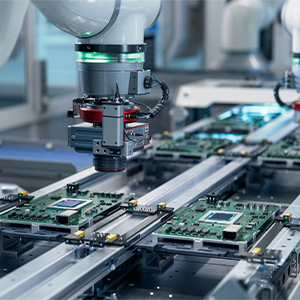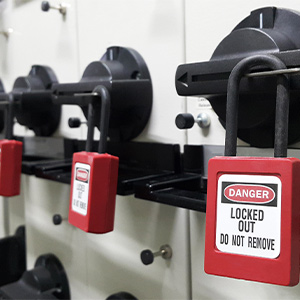Why is Machine
Safety Important?
Post By: Tom Rowse On: 07-11-2018 - Automation & Control - Manufacturing - Safety
What is the first thing you think about when designing and/or installing an automated production system? What's the last? It is a sad fact that the last thing may well be the first in importance, which is the safety of the machines for their human operators, together with the area in which they are situated. Whilst considerations such as cost-effectiveness and efficient production line layouts are certainly critical to the smooth performance of an automated system, more important is that it should pose no threat to human health or life.
Machine safety guards are a crucial interface between a machine and its operator, and a good design that incorporates them from the outset will help to optimise overall performance. The ergonomic design of a machine is also taken into account, for the operator’s long-term health and sanity, more now than was previously considered necessary. More thought is given to the potential for future hazardous events. Furthermore, it is important to ensure that no-one wanders accidentally into a hazardous area of machine operation, so the inclusion of safety fences and sensors should also be considered as a critical part of any design scheme.
Some Statistics
Fatal injuries recorded by the Health and Safety Executive in the manufacturing industries averaged 22 workers per year over the past five years. The largest percentage of these were due to employees falling from a height, but the next highest percentage was due to contact with a machine. Contact with machinery is also responsible for a significant percentage of the 60,000 non-fatal injuries to workers that occurred in the 2016/7 period. In order to contain any further rise in these statistics, it is important to focus on what measures can be taken to protect both people and machines from accidental damage.
HSE Toolbox
The Health and Safety Executive provides some useful tools for evaluating and ensuring machine safety, taking into consideration the many ways in which injuries can be caused, such as:
- unreliable or faulty machines;
- inadequate or improper training and/or protective clothing;
- Crushing and shearing of body parts;
- trapped or drawn in body parts between belts, rollers or pulley drives;
- cuts, stabs or punctures, abrasion and mutilation from sharp edges or rough surfaces;
- burns and scalds from electrical shock, hot surfaces or emissions such as steam;
- impact from moving parts or ejected material.
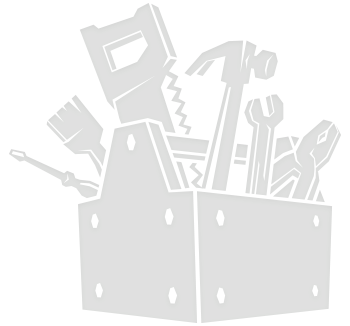
How to Avoid Injuries
Before you allow any machine to commence production, therefore, it is necessary to check that it is complete in all its parts, with all necessary safeguards fitted, fit for purpose and free from any defects. Suppliers of machinery must fit it with all necessary safeguards (which can include light guards, pressure mats, interlocking gates, etc) and inform purchasers of any residual risks still associated with the machine that could not be eliminated in its inherent design. The manufacturer must also identify such risks in the machine’s instructions, so that they can be incorporated into a safe system for workers.
Employers are responsible for establishing safe procedures for operating and maintenance of the machine, which often also requires critical features to be inspected where any deterioration of such features would cause a safety risk. Initially, all static machines must be inspected for proper installation and stability, which usually means being securely fixed down in a safe location, CE marked and carrying a European Declaration of Conformity.
Guarding Standards for Machine Safety
A Code of Practice for Machine Safety was put in place under BS 5304:1975 and 1988, and served British industry for a long period. This is no longer in current use, although it can be obtained from archives at the BSI, as Published Document PD 5304:2014. Given the uncertainty in Britain about its future in the EU, these standards are currently under review and should not in any case be ignored as obsolete. In the meantime, the European Commission instituted a set of legally-binding standards for suppliers, owners and operators of industrial and domestic machines, to ensure conformity of machinery, safety guards and any other safety devices. These standards (sometimes called Euronorms) establish a benchmark of machine safety and incorporate most of the previously encoded principles of the British safety standards.
The Euronorm safety standards are divided into three general groups:
- Type A (basic safety standards)
- Type B1 and Type B2 (safety group standards)
- Type C (machine-specific technical standards)
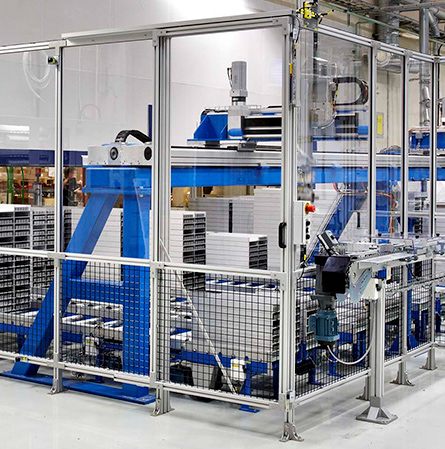
Type A Standards
Type A standards are applied to the essential concepts and design principles of all machines. ISO 12100:2010, for example, lays down the basic terminology and principles for attaining complete safety in the design stage of machinery. It offers a methodology that includes specified principles of risk assessment and reduction that help designers to achieve this objective. These principles are derived from extensive knowledge and past experience of machinery design and usage, including associated risks, accidents and incidents. The ISO describes procedures for identifying and eliminating hazards as well as risk estimation, evaluation and reduction during the relevant phases of a machine’s life cycle. Guidance is also given on the verification and documentation of these risk assessment and reduction processes.
Type B1 and B2 Standards
Type B1 standards relate more to general aspects of safety provision between machine and human operators. They offer solutions to such issues as appropriate safety distances from dangerous areas, to prevent them being reached by human limbs, and minimum gap distances to avoid any crushing of human body parts. They also include the approach speed that is required to calculate the optimum safety distance for such items as multiple light beam safety devices or safety light curtains, and lay down principles for the design of hard safety guards.
Type B2 standards set out the normative requirements for specialised protective devices, such as safety door switches, strips and mats, light curtains and E Stop buttons. The B2 standards prescribe design and testing notes for safety components that must be taken into account by both product manufacturers and the machine’s design engineer.
Type C Standards
Type C standards pertain to significant hazards and specific risks. They include measures for reducing these risks related to specialised machines or machine types. C standards take priority over A and B standards, if there is a C standard in place for the particular machine type. If no special C standard already exists for the proposed machine, or it features additional hazards not already addressed in the C standard for that machine, risk reduction must be addressed according to pertaining A and B standards.
The importance of standards
System engineers designing an automated production line need to familiarise themselves with both UK and European standards, which in more advanced systems can be pre-programmed for optimal design efficiency and safety. Alternatively, you can choose a machine safety specialist to advise you, who may also call in a design team to consult on your particular requirements. Machine safety experts such as those at ABB will undertake the entire design, production and installation of a safety system for your factory or other industrial outlet, which can include anything from a Safety Controller to larger-scale fencing systems.
ISO 14120:2015 is the main standard relating to safety guards, and covers all levels of machinery from the simplest drive couplings to the most complex automated installations, which might include industrial robots, high-speed conveyors and other processing or packaging machinery. The standard incorporates all aspects that must be considered in respect of the design, the machinery, the operators and the construction of guards.
Working with Machine Safety standards
What sort of aspects are included in this consideration? The functions of the machine itself are the first priority, and any hazards that naturally arise from the way it carries out its task. These include the obvious dangers such as impact or entanglement with moving parts, but also include the less obvious potential for ejecting broken tools or coming into contact with hazardous materials or invisible emissions, which can include excessive noise and radiation.
These and other considerations are covered by the European Commission in their Machinery Directive 2006/42/EC. This includes a section on ergonomic principles, which regulates how the physical and psychological safety of machine operators can be affected by such factors as noise and vibration, as well as poor ergonomic design.
Machine safety regulations
In the UK, machine safety is currently governed by two principal sets of regulations, the Provision and Use of Work Equipment Regulations 1998 and the Supply of Machinery (Safety) Regulations 2008, as amended. There are also the existing Health and Safety at Work Act 1974 and the Management of Health and Safety at Work Regulations 1999.
The Supply of Machinery (Safety) Regulations 2008 relate principally to the machine itself, and the tests a machine needs to pass in order to be deemed safe for installation on your premises. The Regulations therefore apply mostly to machine manufacturers and not to the secondary circumstances of machine guarding and safety fencing, but when accepting delivery of a complete or partially assembled machine, you do need to check its documentation carefully to make sure it is fully compliant.
Compliant machinery must be marked with the CE symbol that indicates European Conformity and should carry an accompanying Declaration of such, plus technical information and instructions for safe use. The 2008 Regulations also require the CE mark to be applied to safety components, including machine guards.
Calculating the Risk
Design engineers of any industrial automation system must always calculate the safety risks associated with the installation, operation and maintenance of all equipment, before proceeding to more fundamental logistic problems. They must factor in the probability of any foreseeable injury, and the potential degree of possible harm caused. The Health and Safety Executive have a Risk Assessment leaflet which offers a brief rundown of general risks and how to assess them, while the aforementioned ISO 12100:2010 lays down agreed risk assessment and reduction principles.
If, after such assessment, any machine or component is considered to pose an unacceptable risk, then measures must be applied in a logical order to reduce it to an acceptable level, and repeated until such time as the machine is deemed safe. These measures start at the drawing board, and with HMI design packages are much simpler to test at the initial stages. Any necessary safeguards and associated protective measures must be incorporated and information disseminated for the safe use of equipment. Complex systems may also require additional measures such as employee training, permit-to-work systems, personal protective equipment and establishment of safe working procedures.
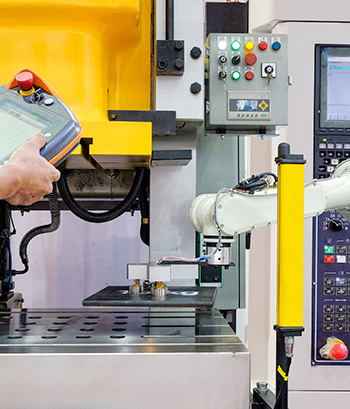
Covering all the Bases
Before initiating any design, a systems engineer should undertake consultation with all the different people who will be involved with using the machinery, during all the phases of its working life from commissioning and production to operation and maintenance. Safety guards also need to be designed to allow the safe loading and unloading of equipment in transit, as well its efficient cleaning and maintenance, bearing in mind that some 25-30% of fatal injuries recorded in the manufacturing industries take place during routine maintenance. Access to potentially hazardous areas and machines should be controlled by interlocked access gates or guards, perimeter fences, light curtains or pressure-sensitive mats, with any non-essential access reduced by designing external lubrication points and/or viewing panels.
Why Safety Guards are Necessary
Most employers these days are aware of essential machine safety issues, and understand that their employees constitute one of the biggest assets in a business. Keeping your employees safe, and taking on board the key principles and components of machine safety, is an economic investment that will improve productivity and reduce employee absences due to injury. Spending on machine safety should not be regarded as a necessary evil, and a well-designed safety system won’t interfere with your machine’s efficient operation. On the other hand, poorly designed or ill-considered safety guards might encourage management, operators and crucial maintenance staff to bypass essential procedures and failsafes, which will significantly increase risks and might also compromise production quality.
Get More From Rowse Straight To Your Inbox


